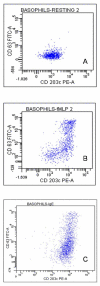Differential response of human basophil activation markers: a multi-parameter flow cytometry approach
- PMID: 18925959
- PMCID: PMC2584049
- DOI: 10.1186/1476-7961-6-12
Differential response of human basophil activation markers: a multi-parameter flow cytometry approach
Abstract
Background: Basophils are circulating cells involved in hypersensitivity reactions and allergy but many aspects of their activation, including the sensitivity to external triggering factors and the molecular aspects of cell responses, are still to be focused. In this context, polychromatic flow cytometry (PFC) is a proper tool to investigate basophil function, as it allows to distinguish the expression of several membrane markers upon activation in multiple experimental conditions.
Methods: Cell suspensions were prepared from leukocyte buffy coat of K2-EDTA anticoagulated blood specimens; about 1500-2500 cellular events for each tested sample, gated in the lymphocyte CD45dim area and then electronically purified as HLADRnon expressing/CD123bright, were identified as basophilic cells. Basophil activation with fMLP, anti-IgE and calcium ionophore A23187 was evaluated by studying up-regulation of the indicated membrane markers with a two-laser six-color PFC protocol.
Results: Following stimulation, CD63, CD13, CD45 and the ectoenzyme CD203c up-regulated their membrane expression, while CD69 did not; CD63 expression occurred immediately (within 60 sec) but only in a minority of basophils, even at optimal agonist doses (in 33% and 14% of basophils, following fMLP and anti-IgE stimulation respectively). CD203c up-regulation occurred in the whole basophil population, even in CD63non expressing cells. Dose-dependence curves revealed CD203c as a more sensitive marker than CD63, in response to fMLP but not in response to anti-IgE and to calcium ionophore.
Conclusion: Use of polychromatic flow cytometry allowed efficient basophil electronic purification and identification of different behaviors of the major activation markers. The simultaneous use of two markers of activation and careful choice of activator are essential steps for reliable assessment of human basophil functions.
Figures









References
-
- de Week AL, Sanz ML, Gamboa PM, Aberer W, Bienvenu J, Bianca M, Demoly P, Ebo DG, Mayorga L, Monneret G, Sainte-Laudy J. Diagnostic tests based on human basophils: more potentials and perspectives than pitfalls: II Technical issues. J Investig Allergol Clin Immunol. 2008;18:143–155. - PubMed
LinkOut - more resources
Full Text Sources
Other Literature Sources
Research Materials
Miscellaneous

